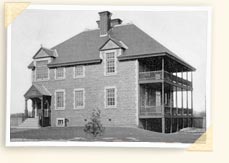 If I had been psychiatrist-in-chief
from 1890 to 1923… If I had been psychiatrist-in-chief
from 1890 to 1923…
I would definitely be a man and I would be known as the medical
superintendent of the Protestant Hospital for the Insane at
Verdun. I would be facing the task of introducing the often
ridiculed "moral treatment of the insane" and would
be working hard at convincing authorities and colleagues to
replace mechanical restraints with a healthy living environment,
a full program of work and amusement, and a kind and humanistic
attitude.
I would have no outpatients, 354 involuntary inpatients—as
voluntary admissions were not permitted by law—and
would have only a few diagnoses to choose from. I would be
treating melancholia and mania, but also 3 types of dementia,
and general paresis, also known as tertiary syphilis. My
observations would also indicate that some ill-fated individuals
suffered from both mania and melancholia. Although by law
we would not be expected to care for “idiots, imbeciles
and morons”, unless dangerous, scandalous, malformed
or epileptic, I would have to be wary of attempts by families
and authorities to have us care for these unfortunates. One
of my main preoccupations would be to deal with pulmonary
tuberculosis, a severe and contagious illness, for which
there was no treatment or cure. As for medications or therapies,
none would be available, and my working tools would be good
food, a good living space and a good attitude.
My 1896 statistics
would prove that we were doing something right: of the 1,279
patients admitted over the previous 6
years, we would consider 447 as cured and 151 as improved.
What other asylum could boast a 47% discharge rate? Unfortunately,
within a few years of opening the Hospital, good living space
would become a problem and overcrowding a top item on my
agenda. My salary for dealing with financial woes, medical
manpower shortages, precariously high staff turnover and
unhappy neighbours fighting our attempts to use our land
to build new pavilions, would not even reach $3,000 a year.
But, then again, in 1905 I would be rewarded by moving from
the main pavilion, where I lived with the other staff, to
the modern and beautiful Burland Villa. I would also enjoy
the benefits of fresh produce from the farm?45 varieties
of fruit and vegetables, and full-time domestic help provided
by our very own patients.
«« Back
|